Deepfake Tools Statistics [2025]
Humanize AI has undertaken a comprehensive study of more than 40 deepfake applications and non-application platforms, including Telegram, forums, and bots, covering both SFW (safe for work) and NSFW (not safe for work) content to understand the current state of available AI tools to create deepfake content.
Disclaimer: To avoid promotion of these tools, specific AI tool names are not mentioned in this study. For detailed information, please feel free to contact us, and we can provide the data upon request.
Key Insights
- The average time for creating a deepfake photo or video is now 27 seconds.
- The development of AI deepfake tools continued to rise, surging by 44% in 2023 and growing by 28% in 2024.
- AI Face Swap remains the most prevalent category, now representing 40% of the tools in the dataset.
- AI Voice Generator has the highest website traffic, reaching 16.8M visits, whereas AI Face Editor leads with 500M app downloads.
- Image-based tools remain the most common, constituting 43% of the dataset, followed by 'Image/Video' tools at 26%.
- Freemium deepfake tools remain the most popular, making up 46%, followed by premium tools at 36% and free tools at 18%.
- NSFW deepfake tools still dominate at 54%, while SFW content grows to 46%.
- A vast majority, 83%, of the tools require user registration.
- 70% of deepfake-related forums primarily focus on the technical aspects of deepfake creation.
- 80% of Telegram channels were found to contain deepfake material.
The Average Time for Creating a Deepfake Photo or Video is Now 27 Seconds
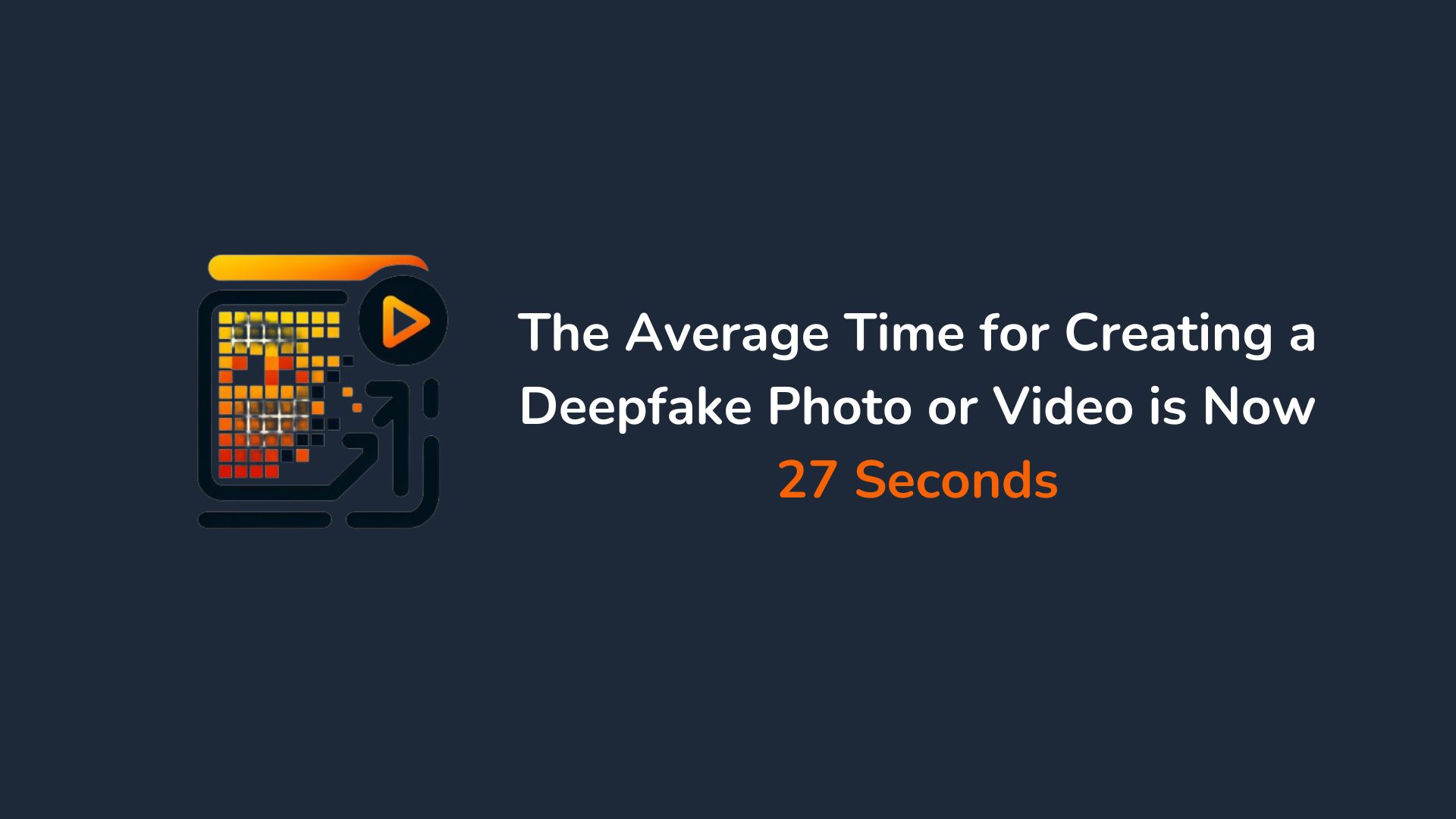
In our research on deepfake tools, we discovered a remarkable fact that the average time required to create a deepfake photo or video has now reduced to 27 seconds due to advancements in AI models, hardware acceleration, and optimized algorithms.
The Development of AI Deepfake Tools Continued to Rise, Surging by 44% in 2023 and Growing by 28% in 2024
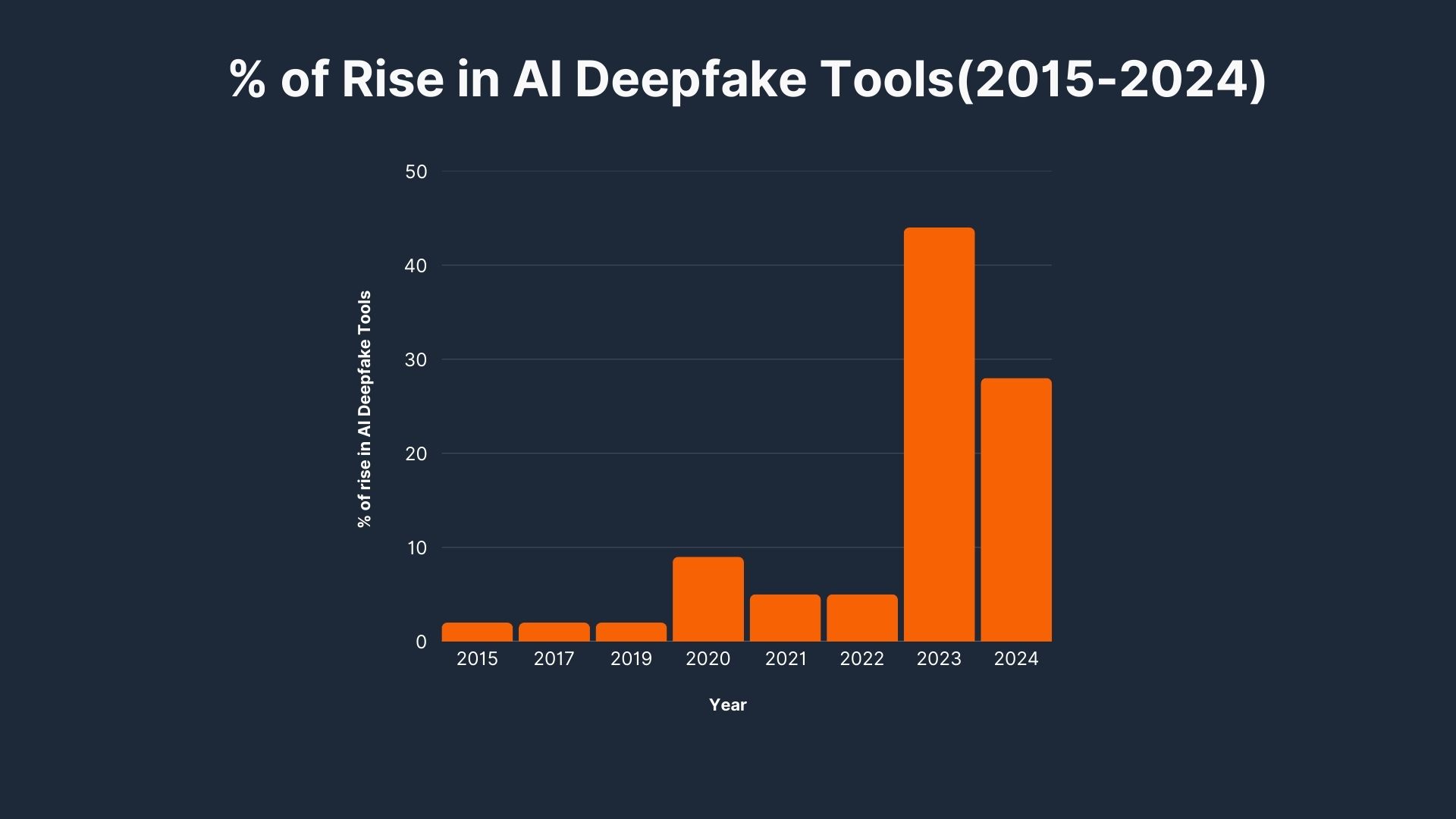
| Year | Percentage (%) | Deepfake Categories |
|---|---|---|
| 2015 | 2% | AI Face Swap |
| 2017 | 2% | AI Selfie Editor |
| 2019 | 2% | AI Face Swap |
| 2020 | 9% | AI Deepfake maker, AI Undress, AI Face Animator, AI Face Swap |
| 2021 | 5% | AI Face Swap, AI Face Animator |
| 2022 | 5% | AI Deepfake Maker, AI Face Swap |
| 2023 | 44% | AI Voice Generator, AI undress, AI Image Generator, AI Image Editor, AI Face Animator, AI Face Swap, AI Undress, Celebrity Deepfake Pornography |
| 2024 | 28% | AI Undress, AI Face Swap |
In an analysis of over 40 deepfake tools, a significant change is observed from 2015 to 2024. Initially, the creation of such tools was limited, with only 2% made in 2015 and 2017. However, by 2023, a dramatic increase occurred, with 44% of these tools being developed. This indicates that in 2023 alone, nearly half of the known deepfake tools were created. The growth continued into 2024, with 28% more tools emerging.
One of the most notable trends in 2024 is the rise of AI Undress tools, making up the majority of newly developed applications. This category, which focuses on generating non-consensual and manipulated images, has seen rapid expansion, raising significant ethical concerns.
These tools have evolved beyond mere entertainment, such as making humorous videos. They now serve a diverse range of purposes, encompassing both SFW (safe for work) and NSFW (not safe for work) content. The applications include face-swapping in photos or videos, creating artificial images or animations, and even generating synthetic voices. The variety of tools is expansive, ranging from mobile apps and websites to dedicated online communities and social media groups.
AI Face Swap Remains the Most Prevalent Category, Now Representing 40% of the Tools in the Dataset
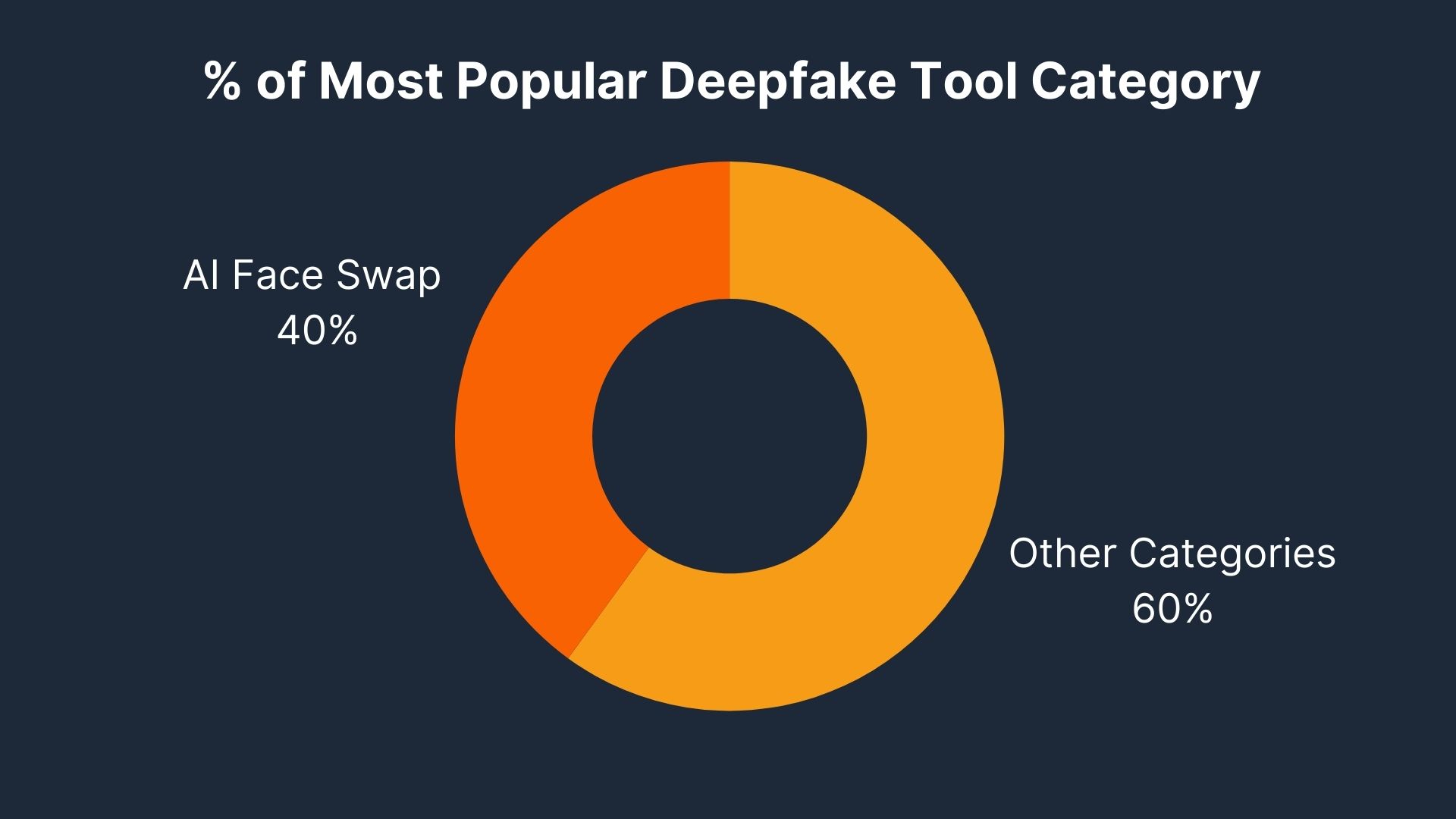
Top 3 Deepfake AI Categories
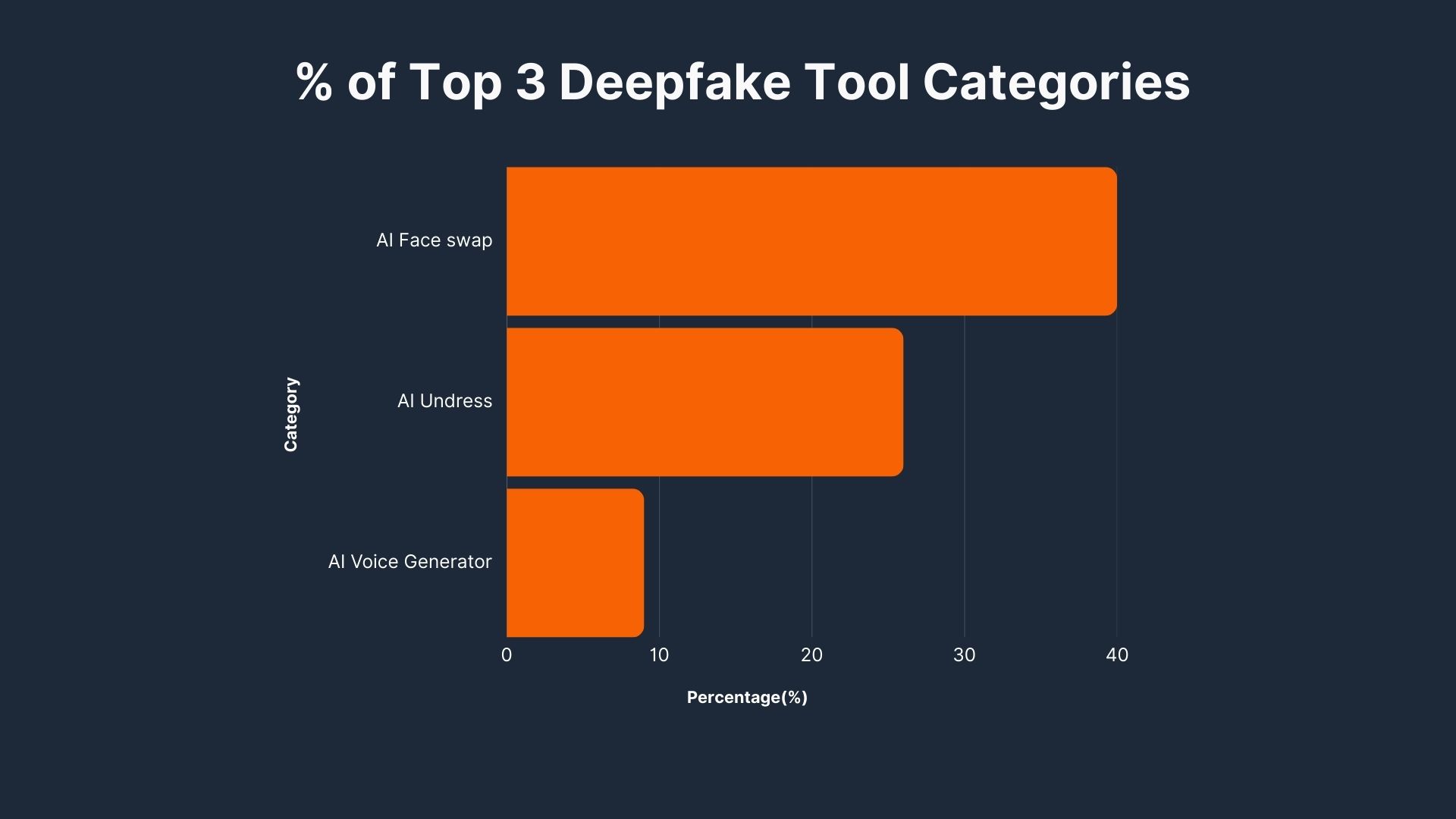
| Category | Percentage (%) | Number of Tools |
|---|---|---|
| AI Face Swap | 40 | 17 |
| AI Undress | 26 | 11 |
| AI Voice Generator | 9 | 4 |
AI Face Swap emerges as the most common category, now comprising 40% of the tools analyzed. Interestingly, AI Undress tools and apps have shown a marked increase, now forming 26% of the tools, with a notable rise in recent months of 2024. Despite initial claims of being free, most of these apps eventually introduce charges.
Additionally, AI Voice Generator tools, representing 9% of the total, are gaining visibility for creating AI-generated voices of celebrities and politicians, increasingly evident across social media sites. These trends highlight the evolving sophistication and widespread adoption of deepfake technology across various digital platforms.
AI Voice Generator Has the Highest Website Traffic, Reaching 16.8M Visits, Whereas AI Face Editor Leads with 500M App Downloads
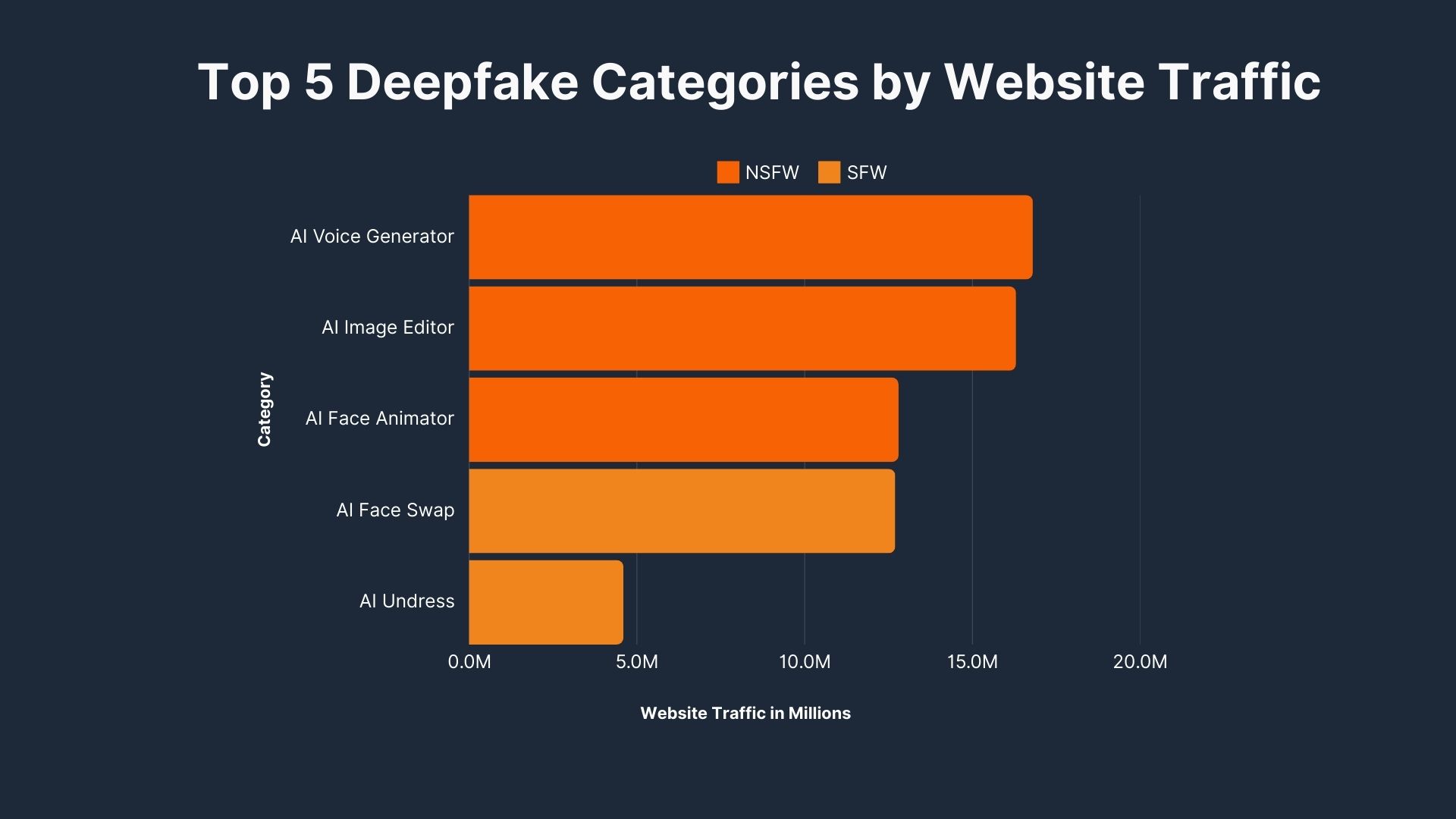
| Category | Website Traffic (M) | Content Nature |
|---|---|---|
| AI Voice Generator | 16.8M | SFW |
| AI Image Editor | 16.3M | SFW |
| AI Face Animator | 12.8M | SFW |
| AI Face Swap | 12.7M | NSFW |
| AI Undress | 4.6M | NSFW |
AI Voice Generator has the highest website traffic, reaching 16.8M visits, whereas AI Selfie Editor leads with 500M app downloads. AI Image Editor follows closely with 16.3M visits, while AI Face Animator and AI Face Swap continue to attract significant traffic. Notably, AI Undress tools have seen a rise, accumulating 4.6M visits, reflecting growing interest in this category.
Top SFW Deepfake Apps by Downloads
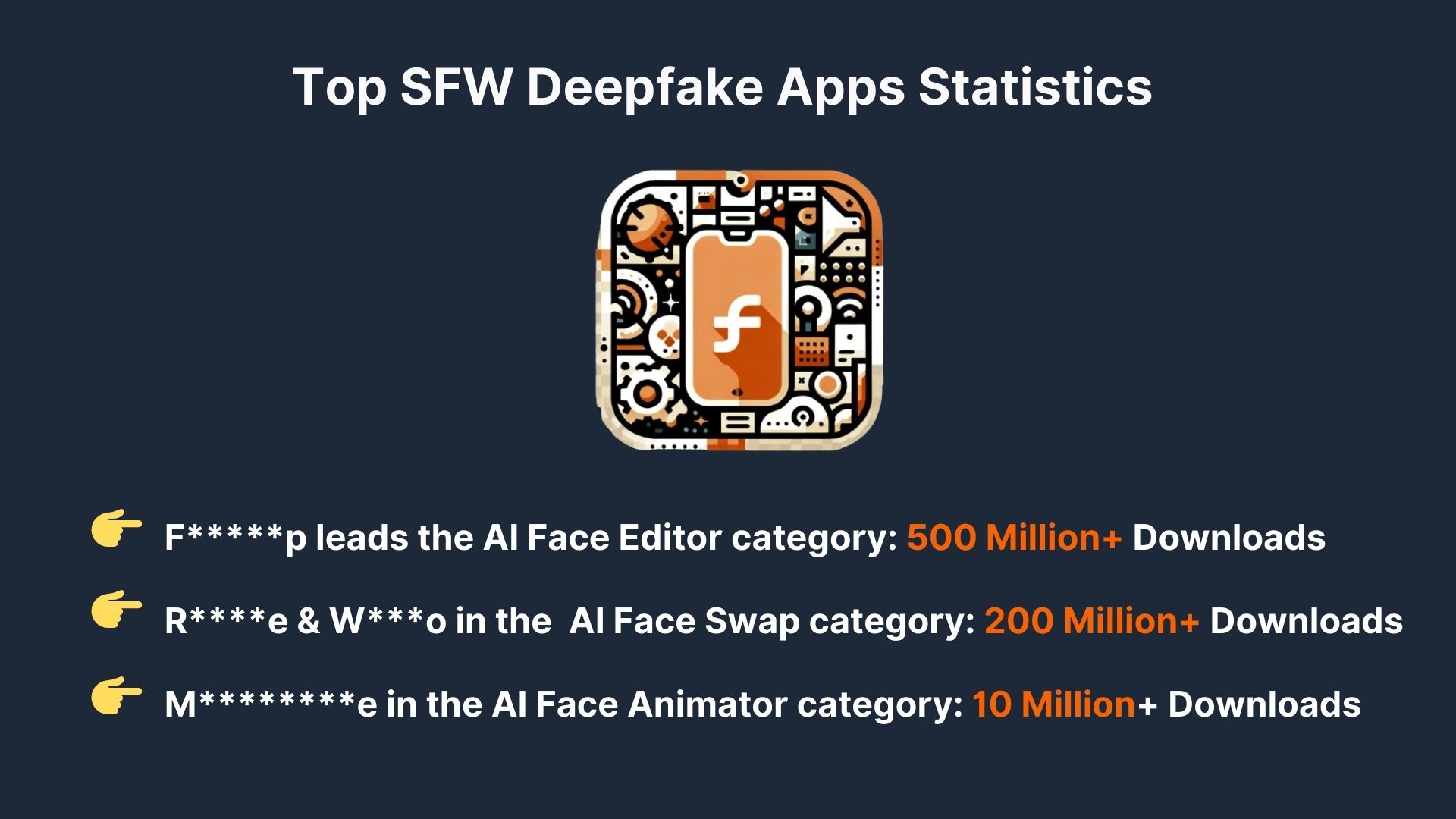
| Category | Tool Name | App Downloads |
|---|---|---|
| AI Face Editor | F****p | 500M+ |
| AI Face Swap | R****e | 200M+ |
| AI Face Swap | W***o | 200M+ |
| AI Face Animator | M********e | 10M+ |
Among the AI tools listed, F****p remains the most popular in the AI Face Editor category, surpassing 500 million downloads. R****e and W****o, both specializing in AI Face Swap, have also gained significant traction, each amassing over 200 million downloads. Meanwhile, M****e leads the AI Face Animator category with over 10 million downloads.
Therefore, AI deepfake websites and apps, including NSFW content, are attracting significant traffic, with AI Voice Generator leading in visits. Safe-for-work (SFW) AI apps like F****p , R****e and W****o continue to dominate in downloads, with FaceApp alone surpassing 500 million installs, highlighting its widespread popularity.
Image Tools Remain the Most Common Type, Constituting 43% of the Tools, Followed by 'Image/Video' at 26%
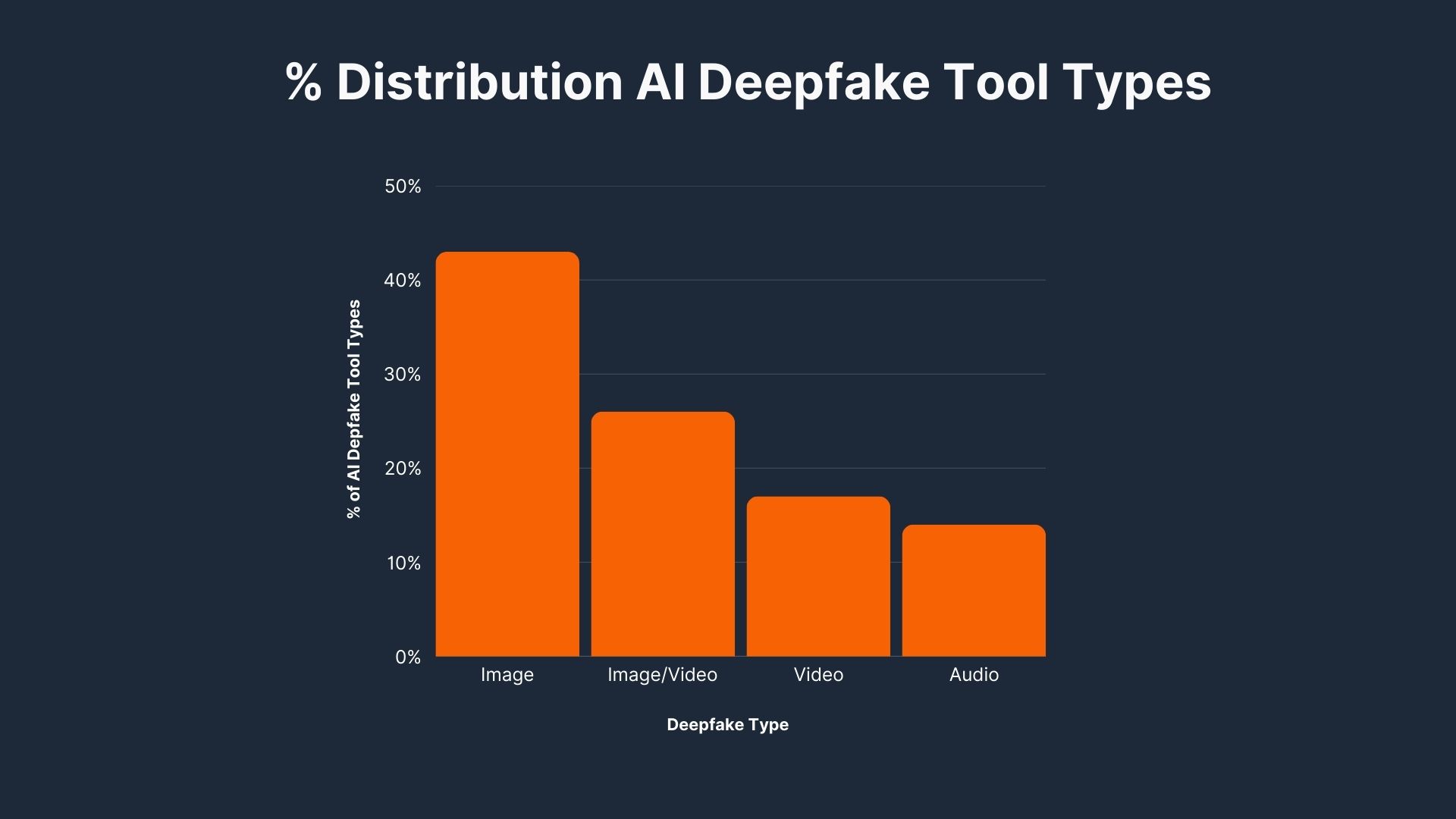
| Deepfake Type | Percentage (%) |
|---|---|
| Image | 43% |
| Image/Video | 26% |
| Video | 17% |
| Audio | 14% |
The most common category is still image-based tools, making up 43% of the dataset. Image/Video tools remain significant at 26%, while video-based tools account for 17%. The audio category has grown to 14%, reflecting an increasing trend in AI voice generation and synthetic voice tools.
Freemium Deepfake Tools Remain the Most Popular, Making Up 46%, Followed by Premium Tools at 36% and Free Tools at 18%
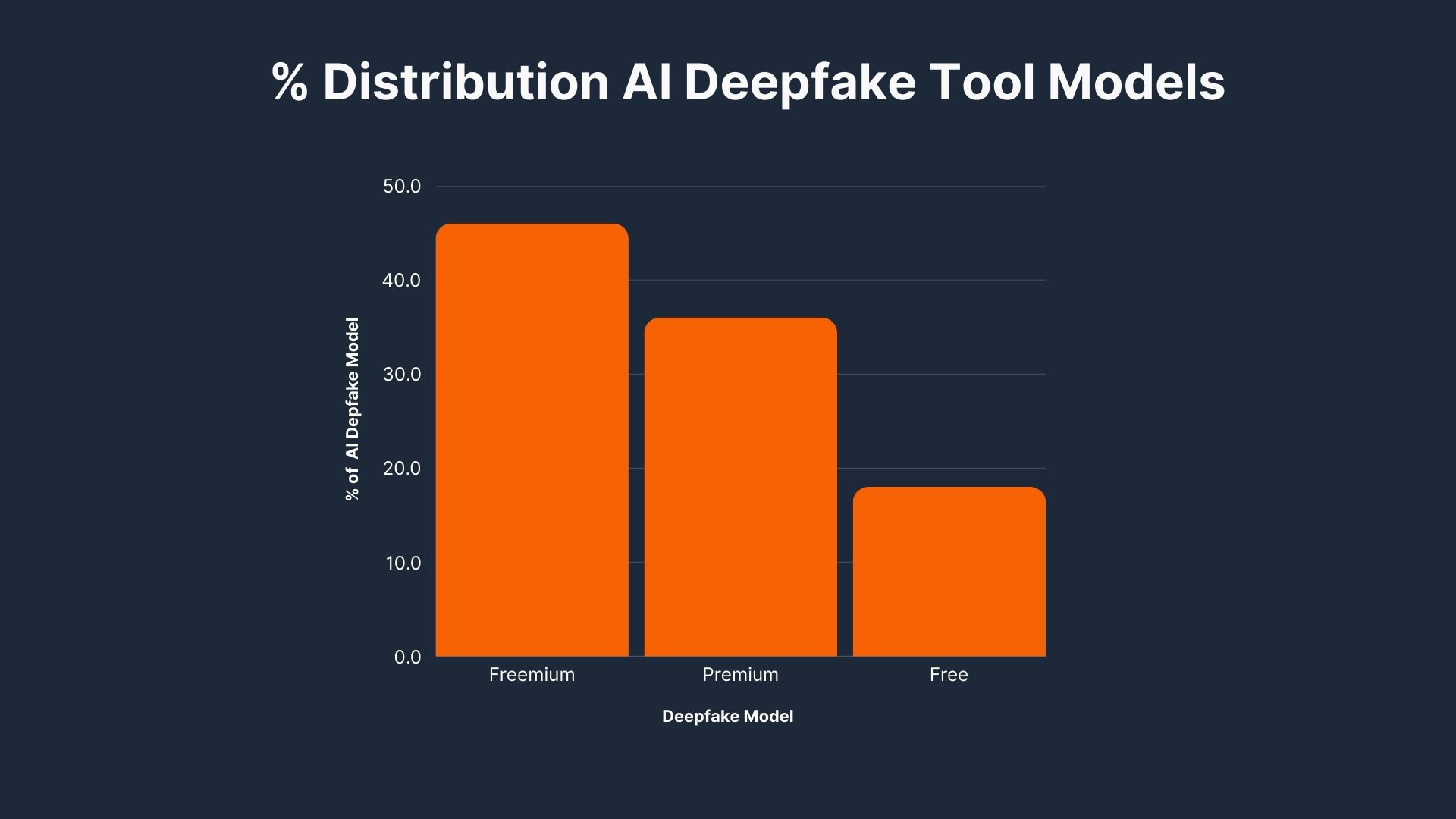
| Deepfake Model | Percentage (%) |
|---|---|
| Freemium | 46% |
| Premium | 36% |
| Free | 18% |
Freemium models dominate, offering free basic services with paid premium features. Premium tools, requiring direct payment, account for 36%, while completely free options are less common at 18%. The trend highlights the shift towards monetizing deepfake technology through flexible pricing models.
NSFW Deepfake Tools Still Dominate at 54%, While SFW Content Grows to 46%
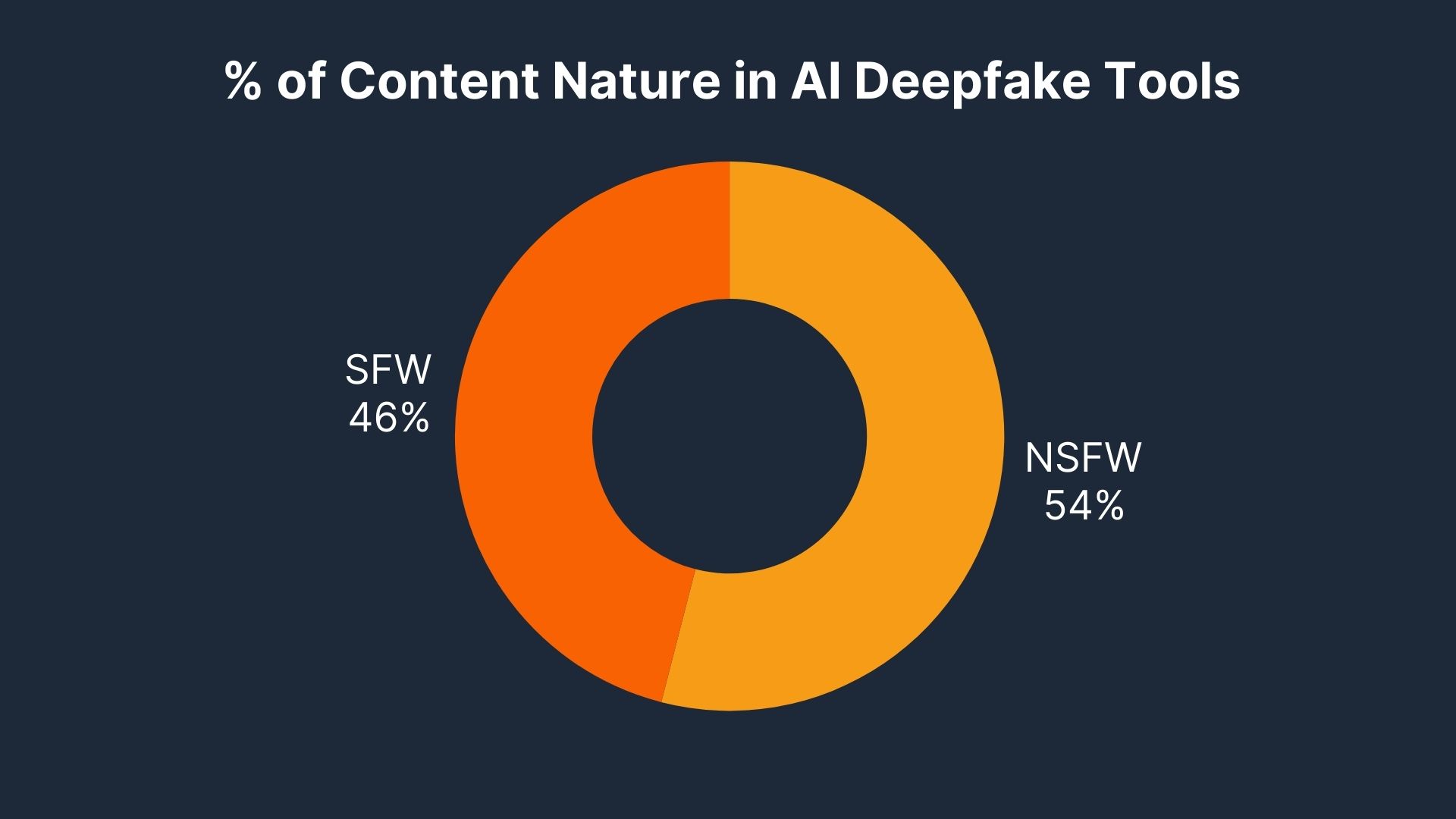
| Content Nature | Percentage (%) |
|---|---|
| NSFW | 54% |
| SFW | 46% |
NSFW deepfake tools continue to dominate the market, making up 54% of all tools. However, SFW deepfake tools have seen growth, now representing 46% of the dataset. While NSFW content remains the majority, its share has declined slightly compared to previous years, reflecting an expansion of deepfake applications beyond explicit content.
The continued prevalence of NSFW(not safe for work) deepfake tools raises ethical and regulatory concerns, as deepfake technology becomes more accessible. Meanwhile, the rise in SFW(safe for work) deepfake tools suggests increasing demand for AI-driven image and video generation in entertainment, business, and personal use.
A Vast Majority, 83% of Deepfake Tools, Require User Registration
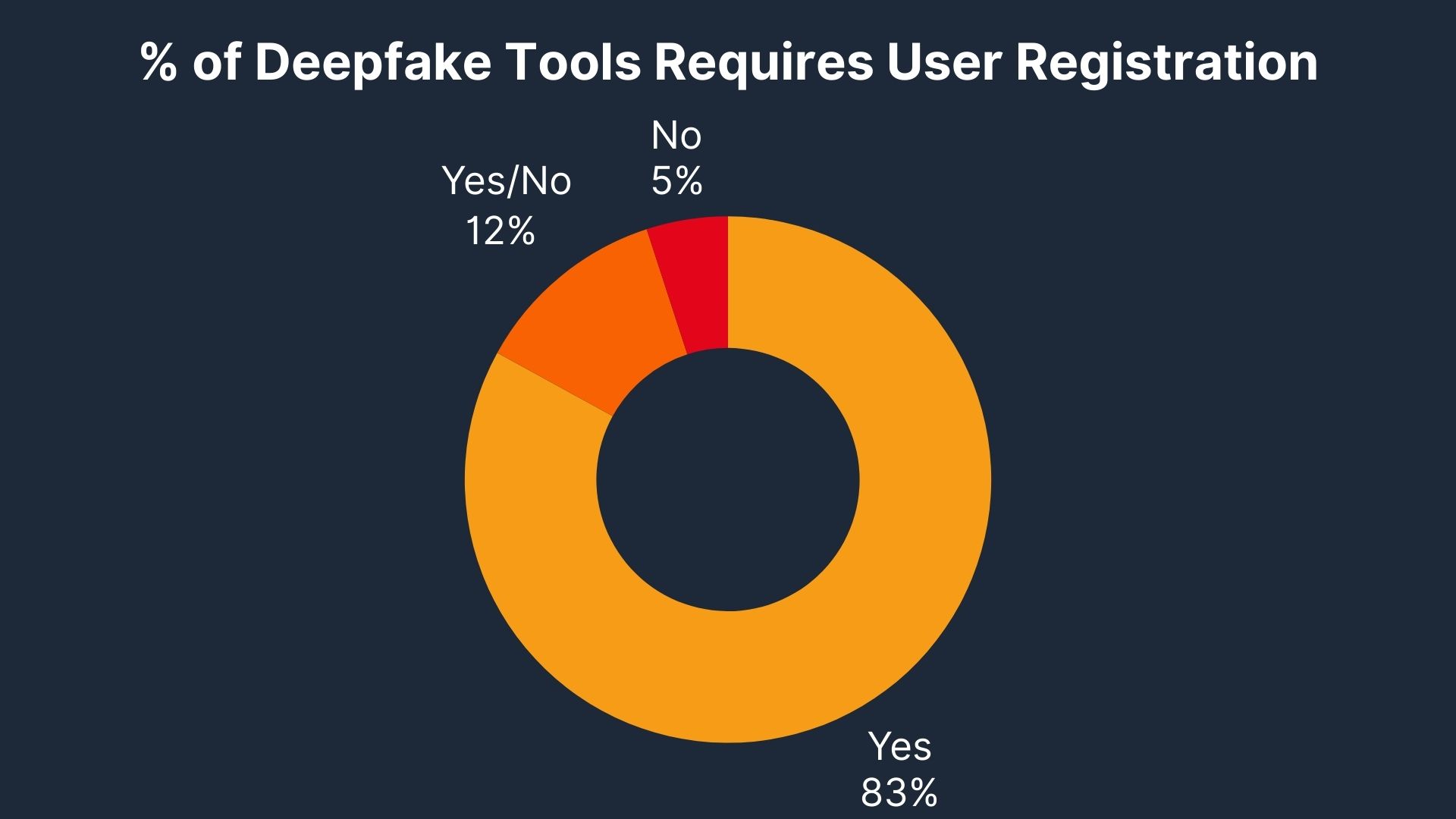
| Registration Required | Percentage (%) |
|---|---|
| Yes | 83% |
| Yes/No (Optional) | 12% |
| No | 5% |
A significant 83% of deepfake tools require user registration, reinforcing a trend towards user identification and data collection. Meanwhile, 12% of the tools provide optional registration, where some features may be accessible without an account. Only 5% of deepfake tools allow complete access without any registration.
The dominance of mandatory registration suggests that developers prioritize user tracking, personalization, and security features. However, the presence of tools with optional or no registration highlights concerns around anonymity and accessibility in the deepfake ecosystem.
70% of the Deepfake-Related Forums Analyzed, the Primary Focus is on the Technical Aspects of Deepfake Creation
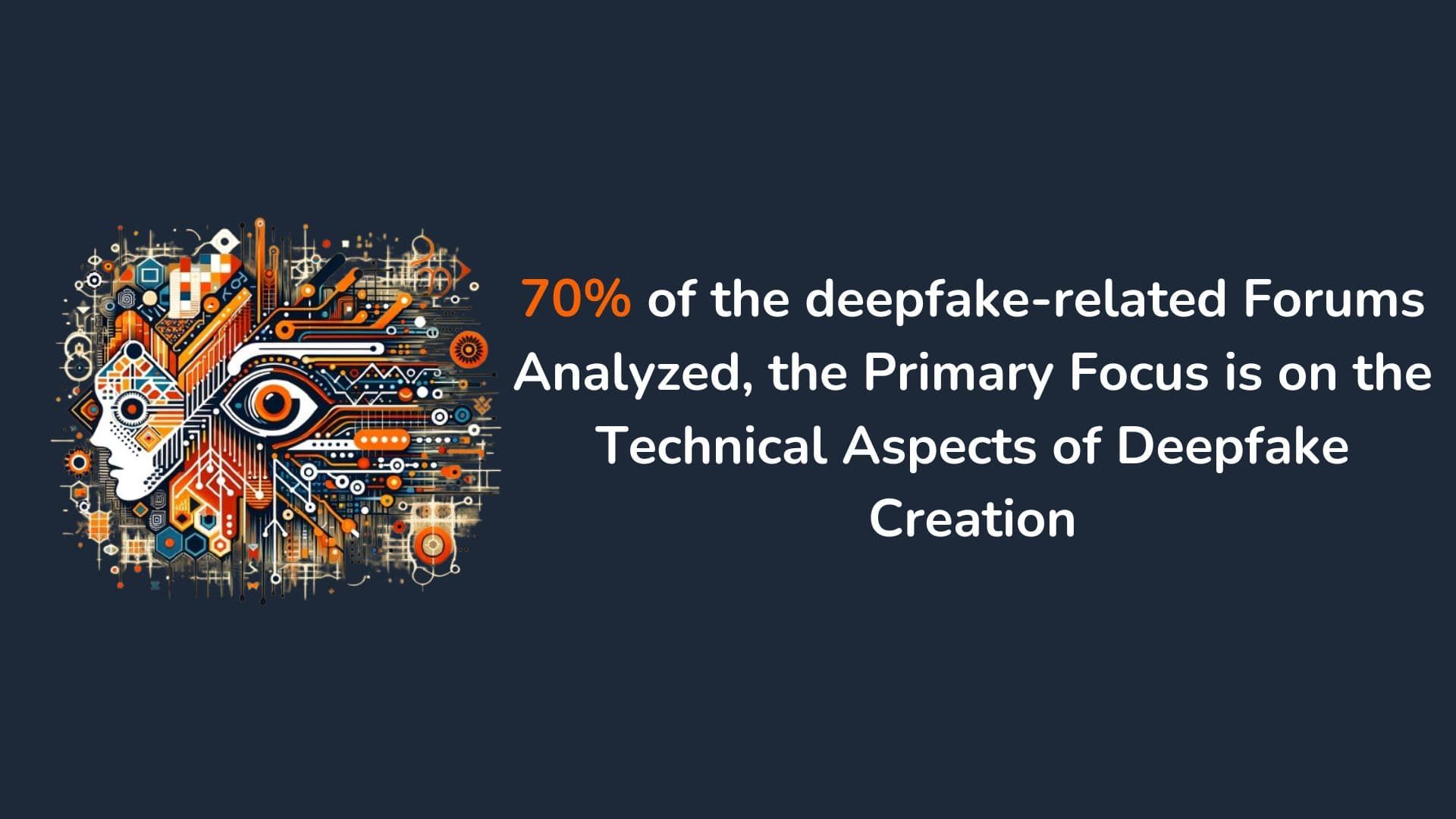
The study of 10 deepfake-related forums reveals that 70% predominantly focus on the technical intricacies of creating deepfakes. This highlights a strong interest in the technological aspects within these communities, suggesting that these forums serve as key platforms for enthusiasts and experts to explore and advance deepfake technology.
80% of the Telegram channels were Found to Contain Deepfake Material
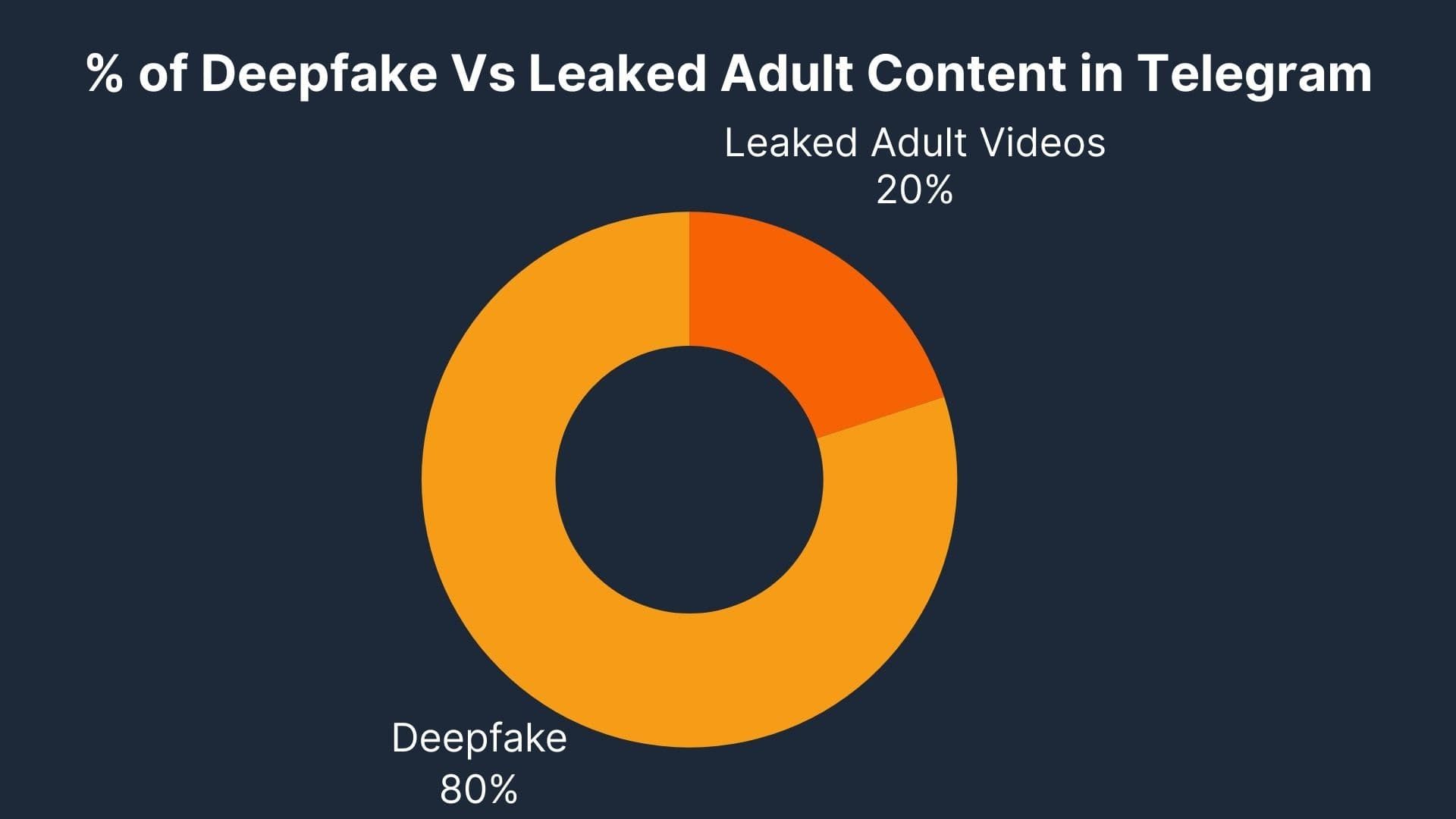
In a analysis of 10 telegram channels related to intimate and adult Content a common process is observed. It typically starts with fake Instagram accounts of girls, which are used to promote and invite people to these telegram groups. Once in these groups, members are exposed to various types of adult and deepfake content.
As the study shows, a predominant portion of these groups 80% engages in sharing deepfake material, which involves digitally altered videos or images that are often deceptive and non-consensual. The remaining 20% of the groups focus on distributing leaked adult videos, which also raises serious concerns about privacy violations and non-consensual sharing of intimate content.
DeepFakeAI: DeepFakeAI Bot Usage and Engagement (December 2024)
As DeepFakeAI continues to expand, its latest statistics highlight rapid growth in user engagement and AI-generated content.
- Platform Usage: DeepFakeAI remains a key player in AI-generated content, enabling users to create custom deepfake videos via Telegram bots and web applications.
- Total Registered Users: The platform now has 10,394 users, reflecting a growing interest in deepfake technology.
- DIY Characters Created: Users have created 438 custom characters, showcasing the demand for personalized deepfake content.
- Video Generation: DeepFakeAI has facilitated the creation of 5,500 deepfake videos through custom Telegram bots and an additional 33,000 videos via its web app.
- Total Custom Bots Deployed: The platform has expanded its reach with 62 custom deepfake bots actively being used.
- Total Video Hours: Collectively, users have produced over 5,600 hours of deepfake video content, indicating high engagement levels.
$FakeAI continues to pioneer AI-generated video content, offering a unique payment system using Wrapped Ethereum (WETH) instead of traditional currency. As deepfake technology advances, DeepFakeAI's ecosystem is set to grow further, enabling more users to explore AI-powered creativity.[6]
Emerging Trends in Deepfake Technology (2025)
- In 2024, deepfake attacks occurred approximately every five minutes, highlighting a notable increase in misuse.[1]
- The deepfake AI market is projected to grow from $1,122.54 million in 2025 to $25,495.16 million by 2034, exhibiting a compound annual growth rate (CAGR) of 41.5%.[2]
- Deepfake-driven cyberattacks are increasingly targeting sectors such as finance and healthcare, exploiting the sensitive nature of data in these industries.[3]
- There is an expansion of scam campaigns utilizing deepfake videos featuring public figures. These campaigns are spreading across multiple languages and platforms, making detection and prevention more challenging.[4]
- The rise of AI-powered "nudification" tools has led to significant ethical concerns. For instance, in October 2024, it was estimated that such deepfake bots on Telegram had up to four million monthly users, indicating widespread usage.[5]
Our Methodology
Selection Process
- We utilized SimilarWeb to analyze the web traffic of deepfake-related tools and websites in january 2025.
- To determine the establishment dates of these tools, we referred to Ahrefs and Wayback Machine (web.archive.org) for historical records.
- We examined over 40 deepfake tools, including web applications, mobile apps, Telegram groups, forums, and AI bots.
Study Scope
For each tool analyzed, we tested and collected data based on the following attributes:
| Attribute | Description |
|---|---|
| Tool Name | Name of the deepfake tool |
| Category | AI deepfake type (e.g., AI Face Swap, AI Voice Generator) |
| Type | Image, Video, or Audio |
| Model | Freemium, Premium, or Free |
| Content Nature | SFW (Safe for Work) or NSFW (Not Safe for Work) |
| Registration Required | Yes, No, or Optional |
| Date of Creation | Launch date of the tool |
| Cost to Create | Minimum cost required to use the tool |
| Accessibility | Web, Mobile App, or Both |
| Ease of Creation | Very Easy, Easy, or Moderate |
| Website Traffic (January 2025) | Monthly visits to the tool's website |
| App Downloads (January 2025) | Total installations for mobile-based tools |
| Average Time for Creating Deepfakes | Time required to generate a deepfake |
Each tool was individually tested to evaluate usability, accessibility, and deepfake generation efficiency. In addition, we monitored deepfake-related forums, Telegram channels, and AI bot interactions to identify emerging trends and risks in the deepfake landscape.
Further analysis included examining deepfake-related communities, such as Telegram groups, forums, and AI-generated content-sharing platforms, to gain deeper insights into user behavior and content distribution. This methodology ensures a data-driven approach to understanding deepfake technology trends, ethical concerns, and potential risks.
Conclusion
AI deepfake technology is evolving rapidly, with 71% of deepfake tools emerging in 2024. However, 65% of these tools generate NSFW content, raising serious ethical and regulatory concerns. The rise in deepfake scams, AI voice cloning, and cyberattacks highlights the urgent need for detection technologies, public awareness, and global regulations.
With AI advancing rapidly, deepfake creation times are shrinking fast—dropping from an average of several seconds in 2023 to just 27 seconds today. This acceleration has fueled disturbing trends like AI-generated undressing, blackmail schemes, and identity fraud, making it even harder to control misuse.
Avoid promoting or using deepfakes for deception. AI-driven social experiments can contribute to misinformation, privacy risks, and even criminal exploitation.
You can also explore Humanize AI's 'Human or AI' social study to test your ability to spot AI-generated faces and better understand deepfake risks: Play now!.
References
- https://www.infosecurity-magazine.com/news/deepfake-identity-attack-every/
- https://www.polarismarketresearch.com/industry-analysis/deepfake-ai-market
- https://www.biometricupdate.com/202409/deepfake-financial-fraud-to-surge-over-the-next-12-months-deloitte-reveals
- https://en.wikipedia.org/wiki/Deepfake
- https://www.wired.com/story/ai-deepfake-nudify-bots-telegram/
- https://x.com/DeepFakeAI_/status/1871039483350577258
